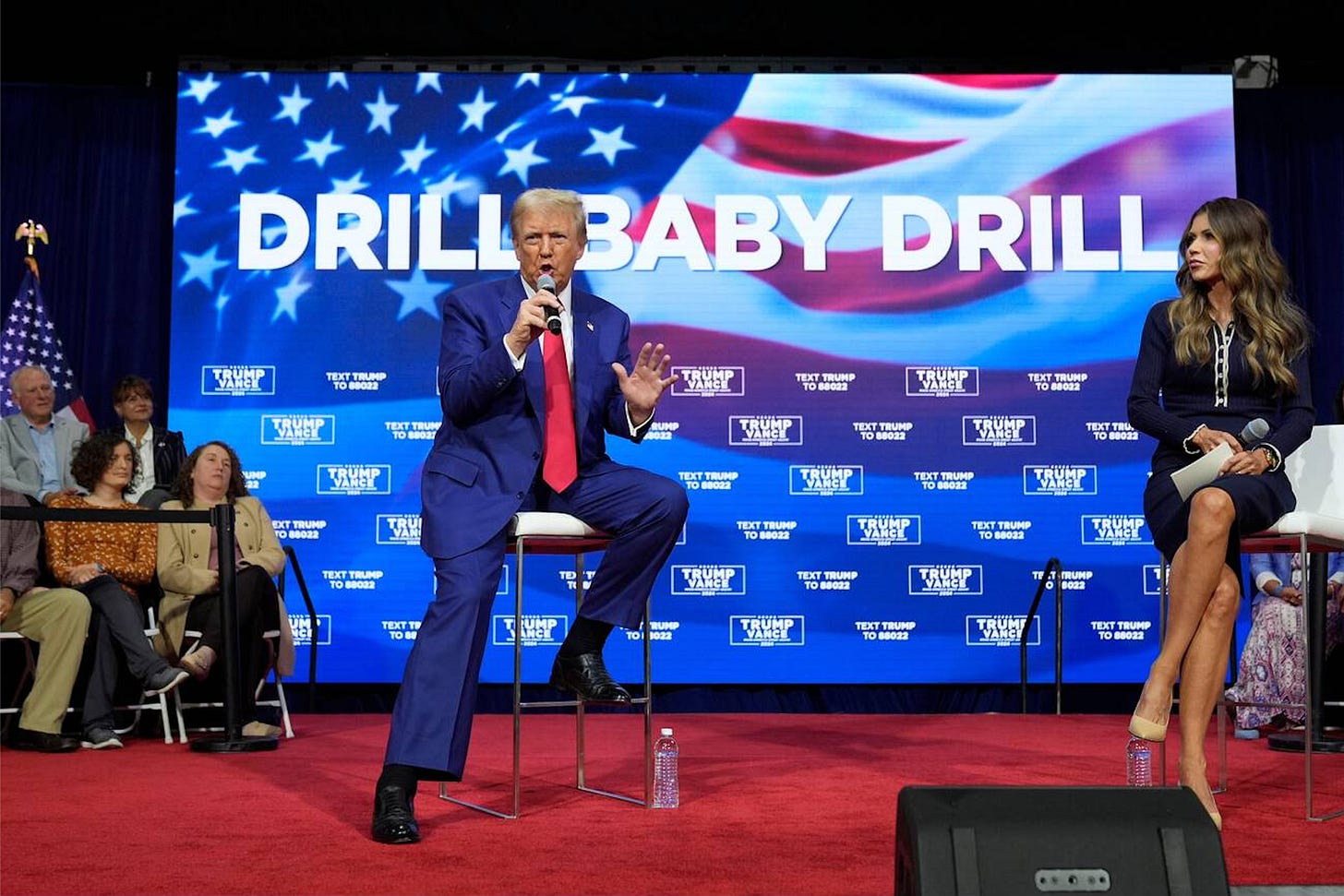Trump's energy policy: "Drill, baby, drill” will be more wind-up than reality
An “all-of-the-above” energy policy is much more likely. Trump is going to be driven by the market, not ideology.
As President-elect Donald Trump turns his attention to re-entering the White House, what will his energy policy be? In line with most of the rest of his manifesto, Trump’s energy policy appears to be mostly about pushing back against establishment norms and a perceived woke agenda and is heavily based on vibes of which the most famous is the Sarah Palin-inspired, “Drill, baby, drill.” But what does this actually mean and how is it different to where we are now?
First of all, the basic facts of the US and its relationship with oil would have remained the same whether Trump or Kamala Harris had won the White House: the US is the biggest oil producer in the world and is roughly 30% ahead of its nearest rival, Russia, and 35% ahead of Saudi Arabia; the US has benefitted massively from Putin’s war on Ukraine with US exporting more Liquefied Natural gas (LNG) to Europe than ever; the US continues to be a major consumer of gasoline with the summer driving season being an annual driver of global oil prices; refining remains a significant industry and the US remains a major importer of oil because so much of its domestic oil production is not suitable for the purposes that the US needs oil for.
Is this a case of “plus ça change, plus c'est la même chose"? Not quite. Since Trump left office in 2021, the energy sector in the US and globally has changed. Oil demand (but not gas demand) is under pressure as recent extensions of production cuts by OPEC have demonstrated, with the oil price stagnating at the $70 mark as global oil production continues to boom. Petrol pump prices right now are lower in real terms than they were 25 years ago even though that may feel hard to believe. The Biden administration has pumped billions of dollars into the renewable energy sector through the Inflation Reduction Act while both India and China are betting each way on hydrocarbons and renewables. The Chinese are adding 1 GW of renewable energy per day right now – that means they’re building the same capacity as the entire UK national grid every six weeks. There are no bat tunnels in China, that’s for sure. But there are no bat tunnels in red states like Texas, Oklahoma and North Dakota either where wind and solar projects are now a huge part of local economies and there will be no appetite from governors and legislatures to dial this investment down.
This is why “Drill, baby drill” is likely to be performative only. And, as we know, the President-elect loves to perform. This means that he’ll make all sorts of claims about drilling in the Arctic to “ensure American energy security” but really he’ll be indulging himself in one of his favourite activities: baiting the progressive left who are bound to fall for it.
In fact, Trump’s pick of Chris Wright, CEO of Liberty Energy, as Energy Secretary tells us what we need to know about where Trump is headed. Like Trump, Wright is a climate change denier but that doesn’t mean he can’t see the benefit of other forms of energy outside of oil and gas. As he put it earlier this year, “We want new energies, but let's just be honest, let’s call them alternative energies or new energies — don't call them clean energy”. Wright’s policy, and that of the administration, is going to be driven by the market not by ideology. Economic pragmatism will be key. As Thomas Pyle of the Institute for Energy Research said in an interview with National Public Radio yesterday, “The industry should make [those] decisions based on the marketplace. To me, it's not about producing more. It's about giving the industry the ability to make those choices free from the hammer of the regulations.”
All this means that, in the halls of power in the US, a different phrase is picking up momentum in Republican circles: forget “Drill, baby, drill” but prepare to hear a lot more about an energy policy that’s “all-of-the-above” where oil, gas, nuclear, wind, solar, geothermal, hydropower, battery storage et al all compete with each other within the US’s energy mix. And yet the use of “all-of-the-above” is a useful reminder of an eternal truth about energy policy, in the US and everywhere else: that if there was a simple solution to the world’s demand for energy, it would have happened by now. After all, President Obama was criticised over 10 years ago for an “all-of-the-above” energy policy, President Biden has faced much the same, President Trump will receive similar brickbats. In truth, “all-of-the-above” is probably the best the US can do right now - as Yogi Berra said, “it’s déjà vu all over again”.




